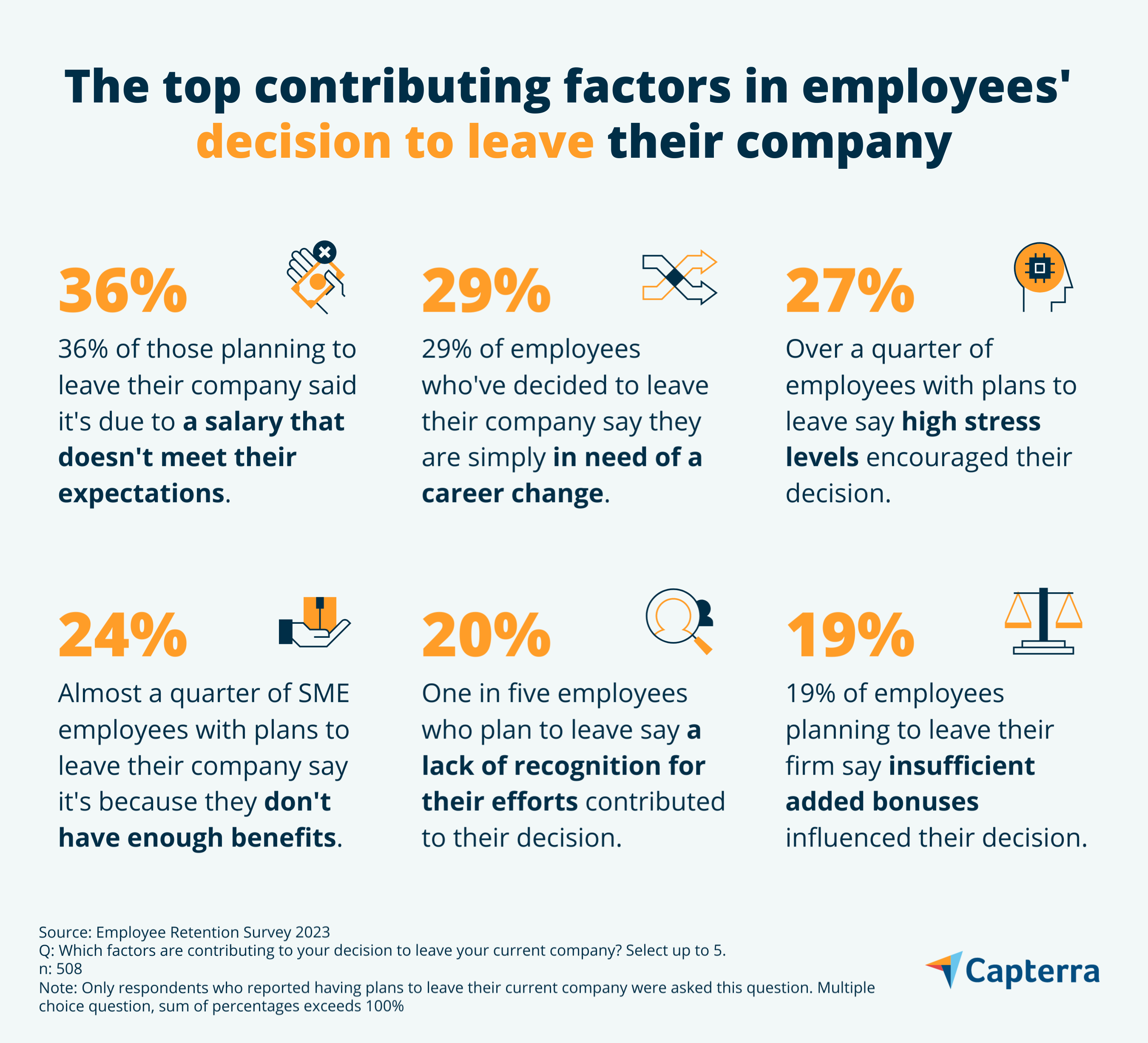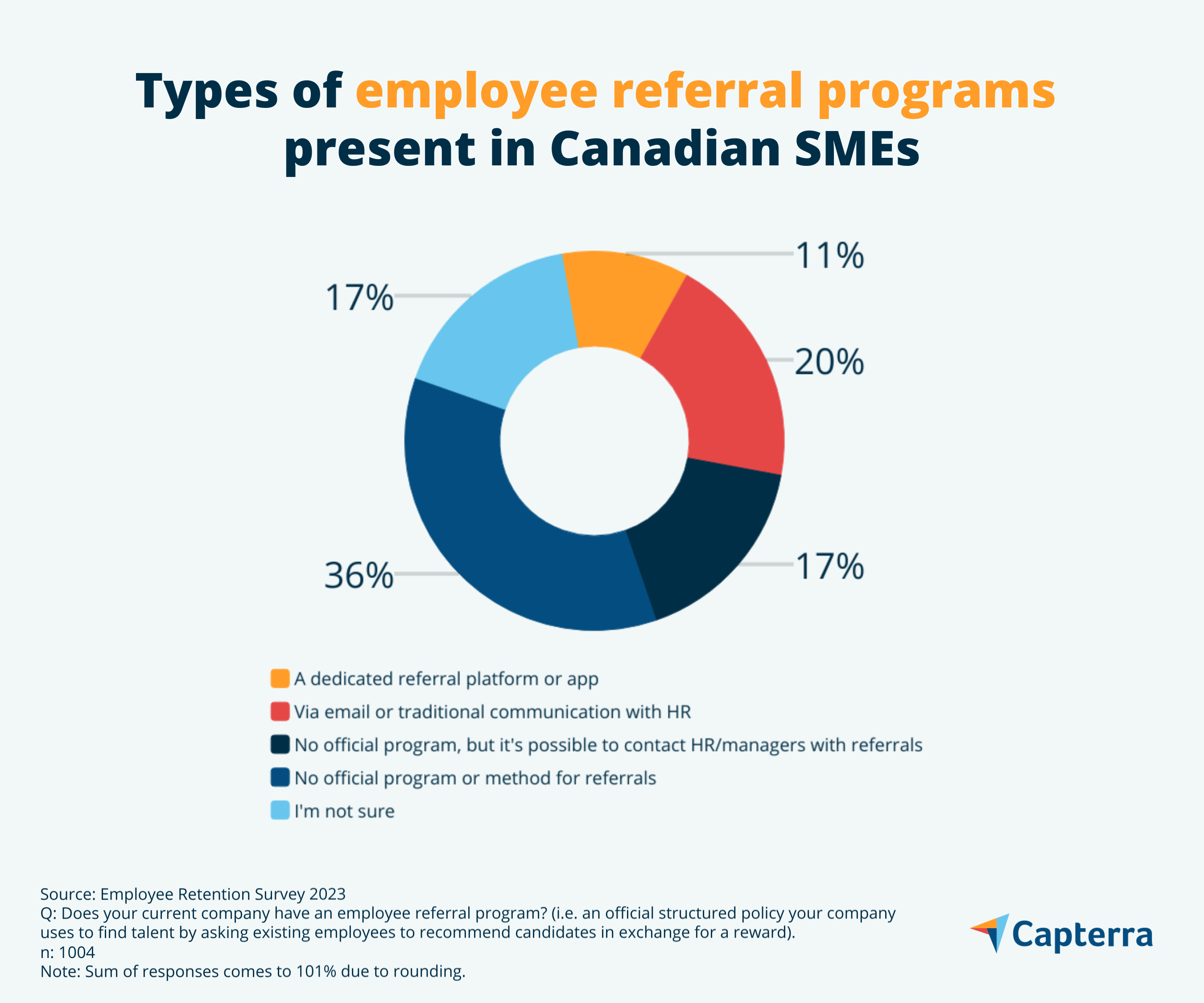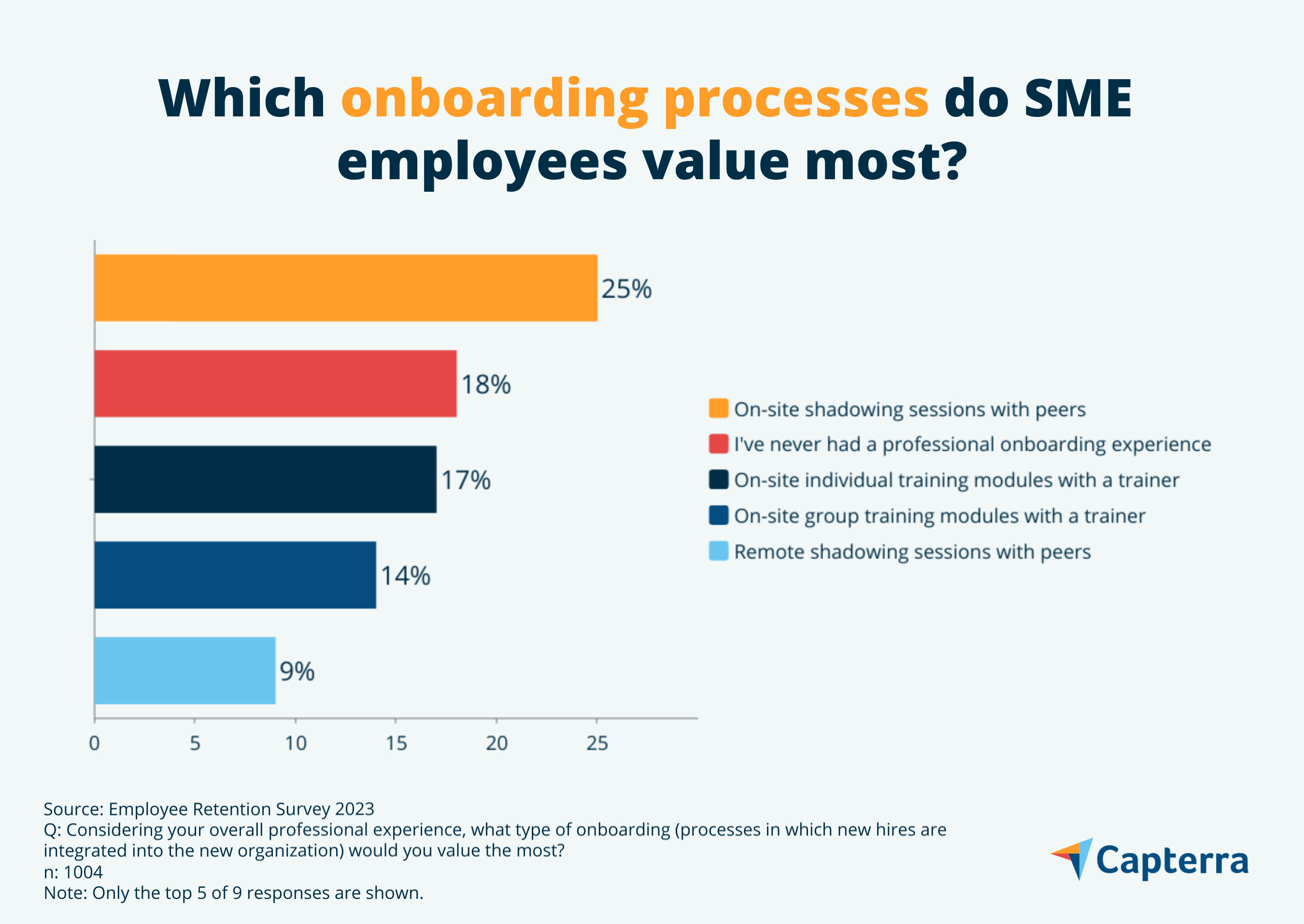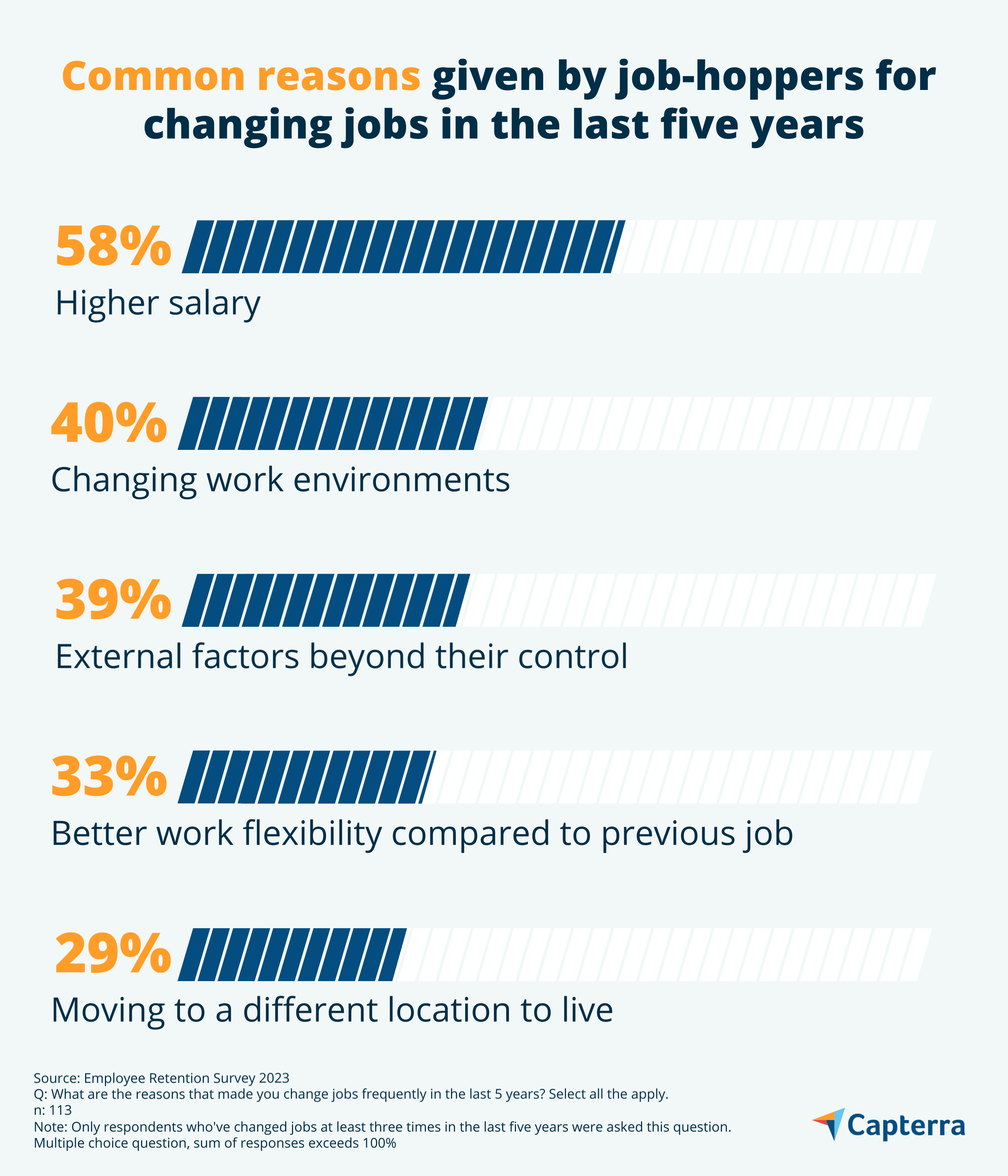Recruiting and retaining top talent is always a challenge for small to midsize businesses. To understand more about how companies can build an employee retention strategy, we asked over 1,000 employees in Canada what would make them leave in their current roles and what could convince them to stay.

In this article
Small to midsize businesses (SMEs) can often differentiate themselves through their people. Having talented, friendly, customer-focused teams is a great way to stand out from the competition —including larger corporations. But no employee sticks around forever, and SMEs need to understand the finer points of retention just like any other organization.
To uncover the best tips for retaining employees, we surveyed 1,004 SME employees in Canada. We asked them about their levels of job satisfaction, what would make them leave or stay in a job, and what they think of HR processes like onboarding, development plans, and referral programs. We also asked them about the HR software they have used and whether they find these tools useful.
In this article, we focus on changing job roles and how employees have experienced the hiring process. Next time, we will look at job satisfaction, personal development, and the role managers can play in retention.
You can scroll down to the bottom of this page for the full methodology.
Job satisfaction is high, but most have one eye on the door
It stands to reason that happy workers are more likely to stay in their job. The good news for Canada’s SMEs is that 62% of employees surveyed say they are satisfied in their current job, and a plurality (42%) said they have no plans to leave. However, just over half said they did want to leave their job at some point, though many didn’t have a specific timeline in mind.

Employees that are looking to change roles gave many reasons. More than one-third said that salary was the biggest driver, but the desire for a career change, high stress levels, and insufficient benefits were also significant factors. Here, we begin to see the mix that influences job satisfaction: financial factors, psychological factors, and career development all play a role.

The 42% who have no plans to leave gave a similar spread of reasons for staying with their current company. Salary was important, but they were more likely to cite a good work-life balance, good relationships with co-workers, and the fact that they find the work fulfilling and meaningful. The top contributing factors for employees who choose to stay with their current employer were:
- Good work environment (good relationship with my co-workers, healthy competition, collaboration, etc.) (49%)
- Work-life balance (47%)
- Salary meets my expectations (38%)
- Flexibility offered (hours, remote or hybrid work) (34%)
- Work is fulfilling and meaningful to me (34%)
However, employees who are happy to stay in their jobs could be tempted to leave with promises of more money elsewhere. 66% said they could change their mind and leave their current company if offered a higher salary. This was by far the biggest potential head-turner, ahead of a higher position (29%) and more flexibility (25%).
Employees like referral programs, but not just for the rewards
Employee turnover is a fact of life for businesses, so anything that makes the process easier is certainly welcome. That’s why many SMEs have adopted referral programs, where employees can recommend candidates for job openings and may get a reward if their recommendation ends up being hired.
Nearly half (48%) of the respondents in our survey said they can refer candidates to their employer, but only 31% say theirs has an official program in place. 11% use a specific digital platform or app for the purpose.

Just over half (51%) of those whose company has an official program have used it to make a referral, and another 41% said they would be interested. This indicates that such programs are both useful and popular, where they exist. And while referrers may stand to get a reward for making a successful referral, their motivations tended to be more altruistic. Respondents who have made a referral said their two biggest reasons were ‘recommending friends/ex colleagues I could easily collaborate with’ (30%) and ‘recommending valuable people to my company’ (30%). Receiving a bonus was only a main benefit for 21%.
Most prefer in-person onboarding sessions
Once a new hire has been identified and they have accepted the job offer, the process of onboarding can begin. This can take many forms in different industries, but formal onboarding appears to be widespread and is often supported with software.
83% said they have been through some kind of onboarding in their career to date, and of these, 70% said they were offered onboarding in their current role. Respondents overall said the most valuable type of onboarding process to them would be on-site sessions shadowing their peers. 25% said they would like this, while 31% said they would like either group or individual sessions with a trainer, also on-site. Employees found remote onboarding options less attractive.

For those who had had onboarding sessions in their current roles, 77% said their company uses software. Most commonly this was a dedicated training tool, but video conferencing and remote support software were also widely used.
But whether on-site or remote, digitized or not, does onboarding work? Employees seem to think so. 74% of those who went through such a process in their current role said their onboarding was useful. Of those who used software (and were able to recall what type), 61% said these tools were useful for onboarding.
More than one in ten are job hoppers
For some employees, moving jobs has become something of a job in itself. In our survey, 11% said they have changed roles more than three times in the past five years.
Many of these ‘job hoppers’ were forced to move for reasons beyond their control, but salary again was a far bigger factor. 58% gave it as a reason behind their frequent moves.

These job hops can come across differently during a job interview. Some employers may see it as evidence that the candidate is ambitious and proactive, always seeking out the roles that offer them the greatest chances of financial and career success. To others, it may be a sign that the candidate can’t settle in one organization, or that they lack loyalty.
According to job hoppers themselves, 42% thought that their frequent moves had no effect on interviewers. However, slightly more thought it had a negative impact (27%) rather than a positive one (22%).
Employee retention strategies are not foolproof
It is important to remember that people can always be motivated to move roles if the benefits are attractive enough. This works both ways for employers: you may need to pay a premium to attract the best talent, but you may also have to accept the fact that some of your most valued employees may be drawn elsewhere. At the same time, don’t underestimate the power of a balanced workplace culture. Good relationships where employees feel valued can be a big factor in retention.
Referral programs and onboarding are a crucial part of the HR process, and employees are comfortable using software for this. However, meeting peers and interacting face-to-face is especially important when starting a new job.
Methodology:
Data for Capterra’s Employee Retention Survey 2023 was collected in June-July 2023. Results comprise responses from 1,004 participants. The criteria to be selected for this study are as follows:
- Canadian residents
- Aged between 18 and 65 years old
- Full time or part time employed at a company with 2-250 employees
- Reports to a manager regularly
- In a junior to executive level role
